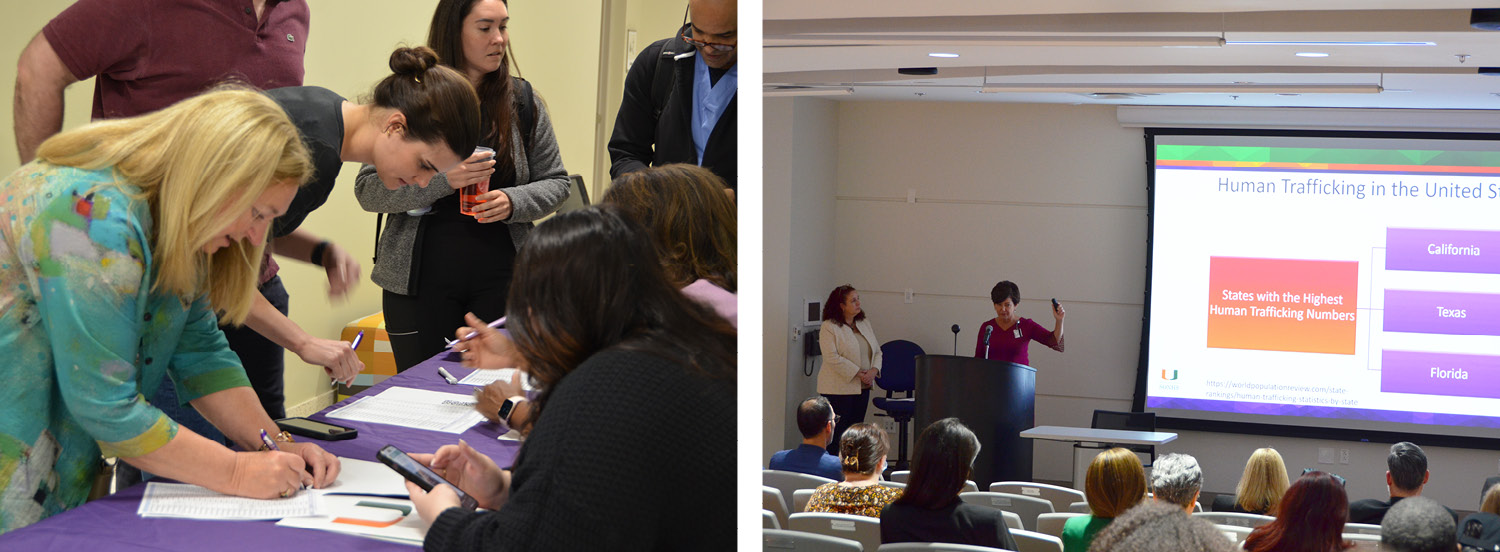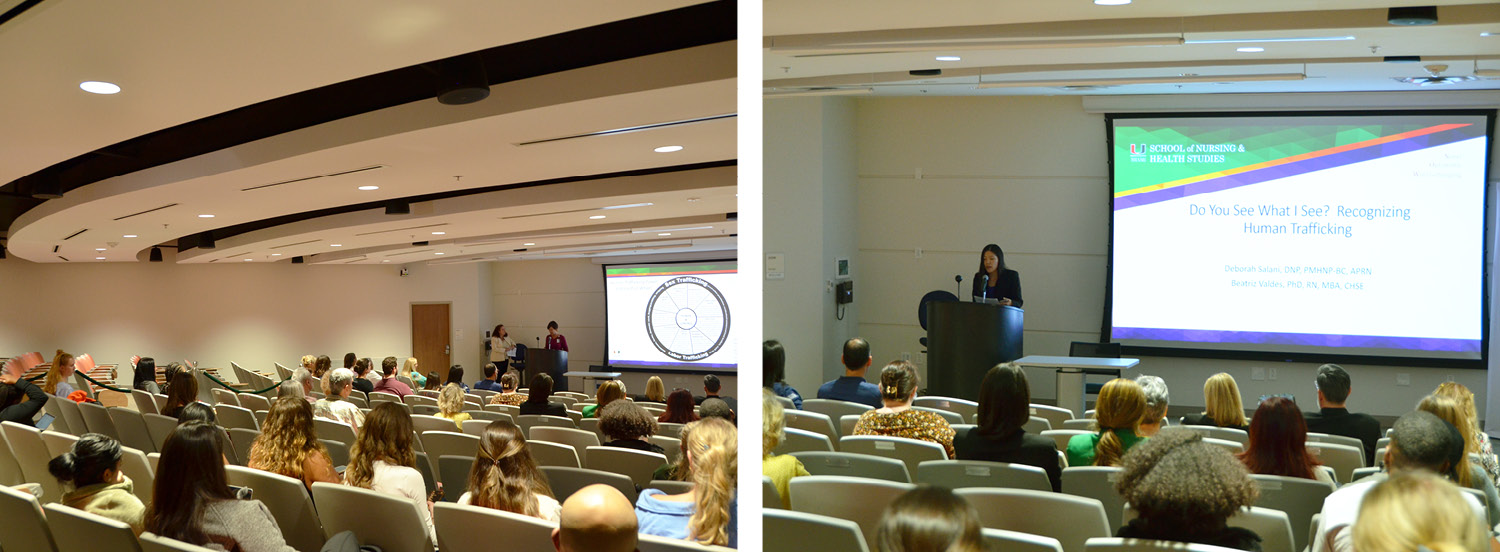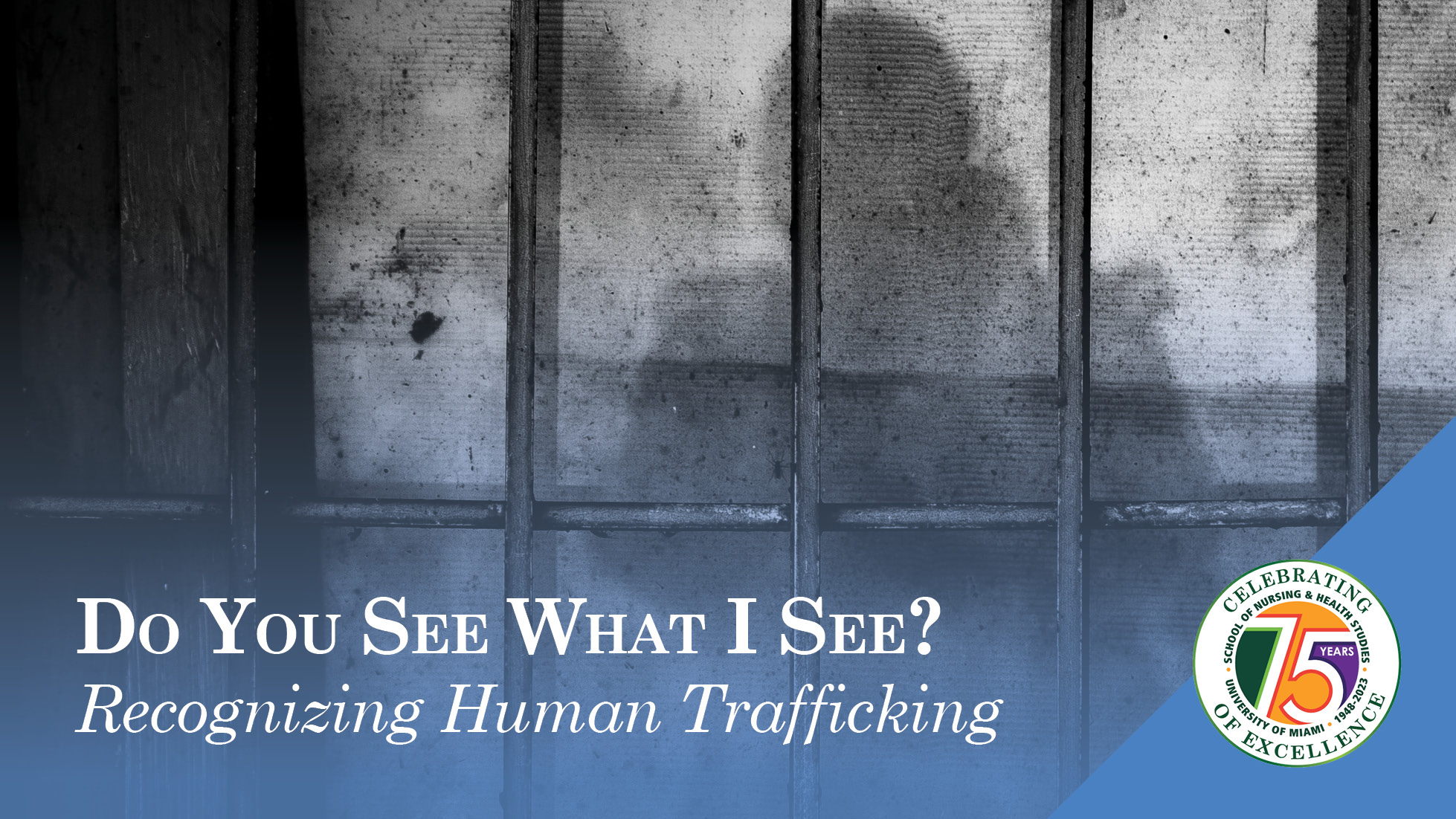Every year millions of men, women, and children are enslaved, exploited, and abused worldwide, including in the United States and our own community of Miami-Dade County. However, they are not easy to recognize because they are being controlled, hidden, coached, and terrorized into remaining unseen. So their plight remains undiscovered, even under the skilled eyes of our health professionals.
On January 30, the penultimate day of National Human Trafficking Prevention Month, faculty experts Deborah Salani and Beatriz Valdes, both associate professors of clinical at the School of Nursing and Health Studies (SONHS), presented the first installment of the SONHS Spring Lecture Series, “Do You See What I See? Recognizing Human Trafficking” in the school’s S.H.A.R.E.™ Auditorium.
Over 100 people registered to hear Drs. Salani and Valdes, who lead the SONHS human trafficking awareness curriculum, examine the different types of human trafficking and discuss its current prevalence.
“I got angry with God,” said “Melissa,” a survivor abducted into sex trafficking at age 14. Melissa’s story was shared in one of the videos presented during the lecture. “I said, help me, help me get away, I don’t know how to get away, I don’t know how to survive. I wasn’t Melissa. I was somebody else. I told [God], that’s it. I can’t survive this anymore. I was going to commit suicide…Most of the girls in there don’t think they could get out.”
Human trafficking, broadly defined as obtaining control of another person for the purpose of exploitation, can happen in any community, the presenters explained. It includes sex trafficking, forced labor, domestic servitude, even involuntary organ removal and egg harvesting.
“Any person forced to work or perform service under threat of penalty or harm is a victim of trafficking,” said Dr. Salani. She explained risk factors for becoming a trafficking victim but emphasized that even though there are established risk factors that tend to make people more vulnerable to exploitation, human trafficking victims can truly be any age, race, gender, and nationality.
Hostages Walking among Us
For the second half of the lecture, Dr. Valdes spoke in depth about the many signals and red flags health professionals should be aware of during an examination that could tip them off to the presence of a potential trafficking victim.
She and Salani discussed the key role of nurse’s in recognizing human trafficking as well as the ways in which nurses and other professionals can become informed about how to best interact with these vulnerable individuals who often present with multiple health concerns and issues of neglect.
“There are a lot of mental health and psychological problems associated with being trafficked as you can imagine,” said Dr. Valdes. “A lot of times they feel hopeless and may be having suicidal ideation. We need to be more cognizant of their situation.” She added that they don’t always want to come out of being trafficked. They may feel they are being cared for, for example, or they are scared or have been warned to mistrust others by their trafficker.
In closing, the educators shared how they have been using a comprehensive and immersive simulation curriculum to help increase the health care community’s proficiency in recognizing human victims of the global trafficking epidemic when they enter their practice.
“We as a school are committed to preventing and mitigating human trafficking,” said Dr. Yui Matsuda, assistant professor at SONHS, who introduced the lecture on behalf of Beta Tau, the school’s award-winning Sigma Theta Tau International chapter, which co-presented the event.
SONHS Dean and Professor Cindy L. Munro has championed the curriculum from the beginning, making it a pillar of the school’s Ever Brighter campaign goals. With her support, Drs. Salani and Valdes were also able to hire 10 standardized patients to help them run scenarios addressing sex, labor, and domestic servitude aspects of human trafficking.
Standardized patients in simulation scenarios are the key to an unforgettable lesson, noted Dr. Valdes. “Some students are so into it that they walk out of the room to call 911,” she said. “They forget they are in a simulation.”
“It’s not something you can read about,” said Dean Munro. “You have to practice it. Recognizing human trafficking should be a skill set just like the one we have when we see someone collapse. When that happens, we know how to perform CPR. We roll right into action.”
The fact that Florida is surrounded by water, with ports for easy access, increases the state’s vulnerability to this multibillion-dollar criminal enterprise, and in Miami-Dade County, noted Dr. Salani, business is booming.
“We could probably say that about 70 percent of Florida’s trafficking cases happen right here in our back yard, our beloved Miami-Dade County,” she said, adding that COVID-19, just like political and financial instability and natural disasters in general, has exacerbated the trafficking problem globally.
The Internet also plays a huge part in this public health crisis, with an estimated 85 percent of traffickers initially soliciting prospective victims online. In a Nightline report shown during the lecture, victims were referred to as “hostages walking among us.” In that piece, the head of Covenant House New York, Jayne Bigelson, explained, “They [traffickers] know what the young person needs,” and use it to lure them. Covenant House, she continued, addresses the real needs of these victims, like housing, therapy, and education.
Teaching Recognition, Raising Awareness
“Despite this global epidemic, we are not educating our providers to recognize who they see in their practices,” said Dr. Salani, adding that it is “very, very alarming” that 64 percent of trafficked individuals are seen by a health care provider while captive without being identified as such during the examination.
Notably, that statistic is greatly improved from over 80 percent, the number being reported around the time she and Dr. Valdes embarked on their mission in 2018. “That was so alarming,” said Dr. Valdes. “We said we wanted to make a difference and decided to develop simulations to help our students recognize the patients who might be victims of trafficking.”
They launched their first human trafficking simulation at S.H.A.R.E.™ in 2019. “If we could educate more health care providers about this topic, more lives would be saved,” added Salani. “Our goal is really getting out there and educating more providers to pick up the signs to recognize these individuals in clinical practice.”
Last year, working closely with S.H.A.R.E.™ nurse educators Amauri Quintana, DNP ’20, and Michelle Arrojo, DNP ’18, they succeeded in educating 260 nursing students at SONHS. “The simulation and accompanying curriculum ensures that when our students are exposed to an event like this in the clinical arena, it won’t be their first time,” said Dr. Quintana.
In fact, during the Q&A portion of the lecture, two former students of the human trafficking recognition program at SONHS spoke up to share stories of how what they learned had indeed helped them to identify a human trafficking victim during a subsequent clinical encounter.
Drs. Salani and Valdes said they have expanded their reach and are now educating public health students, social workers, and medical students, among others. They offer virtual simulation as well.
In the works from Drs. Salani and Valdes is another research project. They want to develop a protocol for facilities to use. “We have called EDs, clinics, urgent care centers—nobody has a screening protocol to rule out human trafficking suspicion,” says Dr. Valdes. “We want to develop some kind of policies and procedures for us in the ED.”
They would be the kind of resources Dr. Valdes wished she’d had while working as a nurse for 30 years. She has only come to know about this issue and the impact nurses can have since she became involved in this effort with Dr. Salani several years ago. Together they have spoken nationally, been awarded grants, and grown the program to its current level of impact.
“We want to publish and network with experts to develop simple protocol quick and fast a few sentences like they do for suicide and domestic violence,” she says. They also want to help promote legislation that would add roadblocks for the traffickers.
Their goal is to perfect the simulation work they are doing, roll it out to big health care systems, and then tweak it to be of help to other professions, such as police officers, TSA officials, teachers, even cosmetologists. They are fully committed. “If anybody asks us to speak to them, we go,” said Drs. Valdes and Salani. We talk to community colleges for free. We do virtual simulation in any course. We do it in public health classes. We network with other schools. As many people as we can train, we do. We want that number of unidentified trafficking victims down.”
If you need help or suspect a case of human trafficking, call or share the Stop Human Trafficking hotline at 1-888-373-7888.



